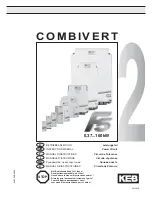
PI2500B & M 12V
4
VELLEMAN
4. Switch the inverter off. The indicators may blink and the alarm may sound briefly; this is normal. Make sure the
test load is switched off and plug it in.
5. Switch the inverter and the test load on. The
PI2500B & M
should supply power to the load. If it does not, refer to
the troubleshooting section of this manual.
5. Permanent Installation
Perform an operational check ("
4. Set-up and Operational Check
" p.4) before installing the device permanently.
a. Installation Location
The permanent installation location should meet the following requirements:
- Dry - water should not be able to drip or splash on the
PI2500B & M
.
- Cool - ambient temperature should be > 0°C and < 25°C; the cooler the better, yet frost-free.
- Ventilated - install the device in a well-ventilated space, and keep a ventilation space of 5cm around the device.
Make sure the ventilation openings (front and back) of the unit are not obstructed as this may cause overheating.
- Safe - do not install the device in the same compartment as batteries or flammable materials or in compartments
requiring ignition protected equipment.
- Install the device as close to the power source as possible to minimize cable length, but do not put battery and
inverter in the same compartment. DC cables need to be as short as possible because of the possible high current.
It is better to use longer AC cables, because the current is lower.
- Mount the device on a flat surface using the mounting flanges on the front and back and #10 bolts.
Mounting hardware should be corrosion resistant. The device can be mounted horizontally or vertically.
b. Battery
The battery you use strongly affects the performance you can expect from your
PI2500B & M
.
Battery type:
the regular lead-acid battery (e.g. car battery) is designed to deliver a large amount of current for a
short period of time (so it can start the engine). Only a small portion of the battery's capacity is used when starting
the engine and it is quickly recharged by the running engine. It is not designed for repeated charge-discharge cycles
where the battery is discharged almost completely and then recharged. If it is used in this kind of deep discharge
service, it will wear out very rapidly.
Deep-cycle lead-acid batteries are specifically designed for deep discharging service. They are marketed for use in
recreational vehicles, boats and electric golf carts.
For most applications of the
PI2500B & M
, we recommend that you use one or more deep-cycle batteries that are
separated from the starting battery in your vehicle by a battery isolator. A battery isolator is a solid-state electronic
circuit allowing the operation of equipment from an auxiliary battery without danger of discharging the vehicle's
starting battery. During vehicle operation, the battery isolator automatically directs the charge from the alternator to
the battery requiring the charge. If the application involved relatively low power loads (< 300W) and relatively short
operating times before recharging (<1h), you may connect the inverter directly to the vehicle starting battery.
Connect the inverter only to batteries with a nominal output voltage of 12V. It will not operate on a 6V battery
and will be damaged if it is connected to a 24V battery.
About batteries:
1. With the exception of sealed gel cell batteries, lead-acid batteries emit hydrogen and oxygen gasses and
sulphuric acid fumes when recharging. Vent the battery compartment to prevent accumulation of these gases,
and do not install electronic or electrical equipment in the battery compartment. Do not smoke or carry an open
flame when working around batteries.
2. The capacity of lead-acid batteries is temperature sensitive. Battery capacity is rated at 25°C. At -20°C, the
capacity will be about half the rated capacity.





































